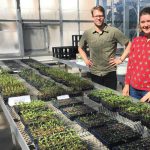BioCycle July 2015
Recycling Act Compliance In Vermont
The next phases of Vermont’s Act 148, the “Universal Recycling Law,” became effective on July 1, 2015. To begin, statewide unit based pricing for trash, also known as “Pay-As-You-Throw,” now requires that all residential trash collection charges be based on volume or weight. All blue-bin recyclables (i.e. plastic, metal, glass) are now banned from the landfill. Any entity that generates 52 tons per year (1 ton/week) of food scraps must now divert that material from the landfill if there is an organics recycling facility within 20 miles of the generator. Public buildings are now required to provide recycling containers alongside all trash receptacles in public spaces, except for restrooms. Additional aspects of the law that went into effect as of July 1, 2015, include: Transfer stations/drop-off facilities must accept leaf and yard debris; and Haulers must offer residential recycling collection at no separate charge. The next major implementation date for Act 148 is July 1, 2016.
NYC Proposes Rules For Large-Scale Food Scraps Generators
On July 2, 2015, New York City Mayor Bill de Blasio proposed organics recycling requirements for large-scale food establishments, vendors, manufacturers and wholesalers in the city’s five boroughs. The proposed requirements are the first step in implementing Local Law 146, a commercial organics disposal ban targeted at large-scale food scraps generators, adopted in 2013. The City is proposing the following subset of facilities to participate in this program: All food service establishments in hotels with 150 or more rooms; All food service vendors in arenas and stadiums with seating capacity of at least 15,000 people; Food manufacturers with a floor area of at least 25,000 square feet; and Food wholesalers with a floor area of at least 20,000 square feet. Businesses covered by this proposal would be given the option to arrange for collection by a private carter, transport organic waste themselves, or compost on-site in an in-vessel composting or aerobic or anaerobic digestion system, subject to compliance with the City’s sewer discharge regulations. The proposed rules will be subject to a public hearing scheduled in September 2015 and a comment period, and would take effect six months after they are adopted. From that point, there will be a six-month grace period before any fines can be imposed.
The first wave of the proposed designation will not include restaurants, grocery stores, fast food establishments or caterers, but the de Blasio administration will propose adding these businesses under future rulemaking as regional processing capacity expands.
“New York City’s restaurants, hotels, and other food service establishments send more than a million tons of organic material per year to landfills,” said New York City Department of Sanitation (DSNY) Commissioner Kathryn Garcia. “This proposal represents the first step toward achieving our Zero Waste goals for businesses by identifying those establishments who are best able to separate a clean organics stream suitable for composting or conversion into clean, renewable fuel.”
Local Law 146’s enacting clause was conditioned on the development of 1,000 tons/day of commercial processing in or around the city by July 1, 2015, stated Marcia Bystryn, director of the New York League of Conservation Voters, who commended the proposed rules. “We recognize there are significant challenges to adding additional capacity — specifically ensuring that already overburdened communities are not negatively impacted — but we still have a long way to go before we can fully implement this law more than two years after it was signed,” said Bystryn in a press release. “As such, we strongly urge the City to consider our recommendations from earlier this year on how to increase processing capacity for organic waste.” These include NYC maximizing use of anaerobic digestion capacity at its wastewater treatment plants (WWTPs); private waste collectors seeking opportunities to codigest high quality organics at WWTPs outside the city; NYC making publicly-owned sites available to facility developers that would be suitable for wet or dry anaerobic digestion technology or composting facilities; and NYC launching a pilot project to create exclusive franchise zones for commercial organic waste.
Regarding processing capacity, DSNY spokesperson Vito Turso said in an interview with Capital New York, “Within 100 miles of the city, DSNY identified between 100,000 and 125,000 tons/year of mostly privately owned and operated processing capacity… DSNY has also identified between five and 10 additional processing facilities within 100 miles of the city that are currently under development, including at least one facility that is scheduled to open in the next year and accept up to 100,000 tons of organic waste per year.”
New Name For U.S. EPA MSW Facts And Figures
In June 2015, the United States Environmental Protection Agency (U.S. EPA) released its annual report on municipal solid waste (MSW) generation, recycling and disposal — with a new name: Advancing Sustainable Materials Management: Facts and Figures 2013. Authors of the report note that the change in title (formerly called Municipal Solid Waste in the United States: Facts and Figures) is intended to switch focus from waste management to Sustainable Materials Management (SMM). According to the report, “SMM refers to the use and reuse of materials in the most productive and sustainable way across their entire life cycle. SMM conserves resources, reduces waste, slows climate change, and minimizes the environmental impacts of the materials we use.”
In 2013, the U.S. generated 254 million tons of MSW (3 million more tons than in 2012), which equates to 4.40 pounds of MSW generated per person per day. About 65 million tons of MSW were recycled and 22 million tons of food scraps and yard trimmings were diverted to composting. Although a similar tonnage was recycled in 2012, there was an increase of 1 million tons of food scraps and yard trimmings composted from 2012 to 2013. In 2013, the recovery rate for recycling (including composting) was 34.3 percent, which is 0.2 percent less than in 2012. The recycling rate in 2013 (including composting) was 1.51 lbs/person/day, with 1.12 lbs/person/day for recycling and 0.39 lbs/person/day for composting. Three material categories had increased recycling rates from 2012 to 2013: yard trimmings (60.2% from 57.7%), selected consumer electronics (40.4% from 30.6%) and food (5% from 4.8%). This represents an increase of 1.01 million tons of yard trimmings composted, 0.27 million tons of selected consumer electronics recycled, and 0.1 million tons of food composted. The authors explain that over the last few years, the U.S. EPA has been heavily invested in material sectors.
Consumer Goods Forum Takes On Food Waste
In June, the Consumer Goods Forum (CGF), a global parity-based industry network comprised of members from the retail and manufacturing sectors, announced approval of a Food Waste Resolution, the third resolution of the CGF’s Sustainability Pillar. The new resolution commits CGF members to halve food waste within operations by 2025, compared to a 2016 baseline. CGF has 400 members, including Unilever, Nestle and Anheuser-Busch InBev. A CGF steering committee has developed an implementation toolkit to help members create a baseline measurement for food waste, establish monitoring and public reporting mechanisms and develop communication and engagement plans.
In addition, the Food Waste Resolution states that CGF members will contribute toward the United Nations’ 2030 goals on reducing wasted food. These include: Halve per capita global food waste at the consumer level; and Reduce food losses along production and supply chains including post-harvest losses and maximize the value of the remaining waste.
GSA And NRDC: “Champions Of Game Day Food”
At the 2015 Green Sports Summit in Chicago, the Green Sports Alliance (GSA) and the Natural Resources Defense Council (NRDC) released “Champions of Game Day Food,” findings of a first-of-its-kind study assessing 20 sports venues across North America that offer healthier food choices and adopt more sustainable practices related to the food system and the environment. Activities highlighted in the report include planning meals with seasonal and local food, sourcing third-party sustainable food and beverages, donating unsold food and diverting wasted food from disposal to composting. Key findings of the study, featured in the report, include: 17 venues provide organic food options; 18 source food from local farms; five have on-site gardens; 14 serve antibiotic-free meats; 14 divert food waste to composting; and seven use compostable foodservice ware. According to the authors of “Champions of Game Day Food,” the benefits of the environmental enhancements are far-reaching, even beyond the venue doors. “Changing the menus at sports venues, which collectively serve hundreds of millions of people each year, offers an influential platform that can educate consumers and the marketplace about healthier food and stronger food systems,” notes report coauthor Alice Henly, Director of Programs at the GSA and Resource Specialist at NRDC.










